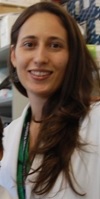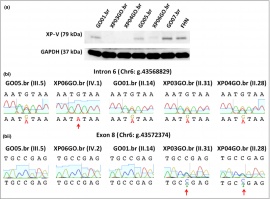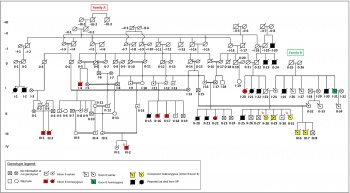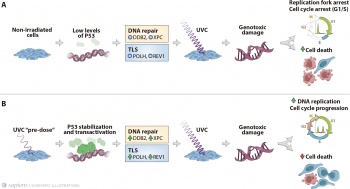Alessandra Pelegrini
From Laboratório de Reparo de DNA
| Revisão de 16:01, 16 Abril 2018 Root (Discussão | contribs) ← Ver a alteração anterior |
Revisão de 14:19, 23 Abril 2018 Root (Discussão | contribs) Ver a alteração posterior → |
||
| Linha 1: | Linha 1: | ||
| {| | {| | ||
| |- | |- | ||
| - | |[[Image:Alepelegrini.jpg|150px]] | + | |[[Image:Ligia.jpg|100px]] |
| - | |Possui bacharelado (2005) e licenciatura (2006) em Ciências Biológicas pela Universidade Federal do Rio Grande do Sul, Mestrado em Biologia Celular e Molecular (2007) e Doutorado em Biologia Celular e Molecular (2012) pela mesma instituição. Atualmente realiza estágio de doutoramento no Laboratório de Reparo de DNA, no Instituto de Ciências Biomédicas da Universidade de São Paulo, sob supervisão do professor Carlos Frederico Martins Menck. | + | |BSc, <b>Biological Sciences</b>, <b>Universidade Federal do Rio Grande do Sul – UFRGS, (2001/2005)</b>.<br>MSc, <b>Celular and Molecular Biology</b>, <b>Universidade Federal do Rio Grande do Sul – UFRGS, (2006/2007)</b>.<br><br> MSc, <b>Celular and Molecular Biology</b>, <b>, Universidade Federal do Rio Grande do Sul - UFRGS and Universidade de São Paulo – USP, ( 2007/2012)</b>.<br><br>Has experience in Cell Biology, Molecular Biology and Next Generation Sequencing (NGS) on the identification of causative mutations for Mendelian diseases related to DNA repair deficiencies. <br><br> The researcher has experience in cell and molecular biology, culture of human and animal cells, proteomics and mass spectrometry, microscopy and immunofluorescence, drug testing and cytotoxicity.<br> Research keywords: <b>Cancer</b>, <b>DNA repair,/b>, <b>Replicative stress</b>, <b>Genetic instability</b> and <b>Chemotherapy and Therapeutic resistance</b><br> [http://buscatextual.cnpq.br/buscatextual/visualizacv.do?id=K4463877A9 Lattes]. |
| - | <br> | + | <b>Contato:</b> aleepelegrini[at]gmail.com |
| - | + | ||
| |- | |- | ||
| |colspan=2| | |colspan=2| | ||
| - | == Resumo do Projeto == | + | == Current Project == |
| - | ===O silenciamento da cinase humana Nek1 altera o reparo normal do DNA=== | + | ===Genotypic and phenotypic characterization of xeroderma pigmentosum (XP), cockayne syndrome (CS) and trichothiodystrophy (TTD) patients in Brazil === |
| - | + | Deficiencies in nucleotide excision repair lead to human disorders where patients | |
| - | A proteína humana Nek1 pertence a uma família de serina/treonina quinases caracterizadas pelo seu envolvimento no ciclo celular que estão presentes em diferentes organismos. Nos últimos anos, cada vez mais estudos estão se focando nessa família de proteínas devido sua relação com patologias do desenvolvimento e à suscetibilidade a tumores. A Nek1, por exemplo, parece estar envolvida na etiologia de duas síndromes hereditárias, a Doença Policística do Rim e a Síndrome de costela curta e polidactilia tipo Majewski. Entretanto, as bases moleculares que relacionam a deficiência dessa proteína a essas patologias não estão estabelecidas. Por isso, alguns estudos buscam entender a função da Nek1 e os achados mais promissores destacam seu papel na ciliogênesis e na resposta ao estresse genotóxico, sugerindo a Nek1 como uma molécula sensora de danos ao material genético e até mesmo participando ativamente de vias de reparo. | + | display photosensitivity and/or neurological problems, such as xeroderma pigmentosum |
| + | (XP), cockayne syndrome (CS) and trichothiodystrophy (TTD). Case reports and | ||
| + | genotypic descriptions of patients have been published worldwide, mainly in North | ||
| + | America, Europe, Africa and Japan. The follow up of these patients for decades and the study with these | ||
| + | cells led to the understanding of what is currently known about the molecular pathways and genetic | ||
| + | defects involved in the phenotypes of these syndromes. In Brazil, a few case-reports describe some patients | ||
| + | with these phenotypes, and genetic and molecular characterizations are scarce. With the possibility to | ||
| + | identify mutations directly by Next Generation Sequencing (NGS) technique, we initiated a project to | ||
| + | diagnose the mutations involved in these NER syndromes, mainly XP. Therefore, we also plan to investigate | ||
| + | the origins of these mutations and ancestries by the analysis of haplotypes with SNP-array assays. | ||
| + | <br> | ||
| <br> | <br> | ||
| - | Em nosso trabalho, através do estudo de células silenciadas por RNA de interferência (figura 1), encontramos um retardo no reparo do DNA em células renais humanas quando tratadas com os agentes genotóxicos metil-metanosulfonato, peróxido de hidrogênio e cisplatina. Quando silenciadas para Nek1, as células não conseguem reparar principalmente as lesões do tipo crosslinks causadas pela cisplatina, como demonstrado através do ensaio cometa nas versões alcalina e neutra (Figura 2). Em vista disso, o objetivo desse projeto é investigar o papel da Nek1 em resposta a lesões causada pelo quimioterápico cisplatina, um indutor de pontes inter e intracadeia de DNA (crosslinks), tentando estabelecer a via de atuação dessa proteína. | ||
| <center> | <center> | ||
| + | [[Image:Munfordcastroetal2.jpg|270px]] | ||
| + | [[Image:Munfordcastroetal.jpg|350px]] | ||
| + | [[Image:lerner.jpeg|350px]] | ||
| <br> | <br> | ||
| - | [[Image:Alepelegrinifigura1.jpg|350px]] | ||
| <br> | <br> | ||
| - | western-blot demonstrando o silenciamento de Nek1 por shRNA nas linhagens trabalhadas | ||
| - | <br><br> | ||
| - | [[Image:Alepelegrinifigura2.jpg|350px]] | ||
| - | <br> | ||
| - | O Silenciamento da Nek1 altera o reparo normal do DNA de células expostas a Cisplatina. Células Hek293T Wild-type (WT) e silenciadas para Nek1 (KD) foram tratadas com cisplatina por 1h e após diferentes tempos de recuperação o cometa alcalino ou neutro foi realizado conforme descrito em Pelegrini et al., 2010. | ||
| - | <br><br> | ||
| </center> | </center> | ||
| - | ==Publicações== | + | == Publications == |
| - | Pelegrini, A. L. ; Moura, D. J. ; Brenner, B. L. ; Ledur, P. F. ; Maques, G. P. ; Henriques, J. A. P. ; Saffi, J. ; Lenz, G. (2010). Nek1 silencing slows down DNA repair and blocks DNA damage-induced cell cycle arrest. Mutagenesis, 25,447-454. | + | Munford V*, <b>Castro LP*</b>, Souto R, Lerner LK, Vilar JB, Quayle C, Asif H, Schuch AP, de Souza TA, Ienne S, |
| - | <br><br> | + | Alves FIA, Moura LMS, Galante PAF, Camargo AA, Liboredo R, Pena SDJ, Sarasin A, Chaibub SC, Menck CFM |
| - | Gerhardt, D; Horn, A. P. ; Gaelzer, M. M. ; Frozza, R. L. ; Delgado-Cañedo, A. ; Pelegrini, A. L. ; Henriques, Amélia T. ; Lenz, G. ; Salbego, C. (2009). Boldine: a potential new antiproliferative drug against glioma cell lines. Investigational New Drugs, 27, 517-525. | + | (2017). A genetic cluster of patients with variant xeroderma pigmentosum with two different founder |
| - | </center> | + | mutations. <u>British Journal of Dermatology.</u> 176 (5), 1270-1278. <br> [https://onlinelibrary.wiley.com/doi/abs/10.1111/bjd.15084 Full Text] [https://onlinelibrary.wiley.com/doi/abs/10.1111/bjd.15435 Highlighted Comment] <br><br> |
| + | Pedroso JL, Munford V, Bastos AU, <b>Castro LP</b>, Marussi VHR, Silva GS, Arita JH, Menck CFM, Barsottini OG | ||
| + | (2017). LMNB1 mutation causes cerebellar involvement and a genome instability defect. <u>Journal of the | ||
| + | Neurological Sciences.</u> 379:249-252. <br> [https://www.sciencedirect.com/science/article/pii/S0022510X1730401X?via%3Dihub Full Text] <br><br> | ||
| + | Lerner LK, Francisco G, Soltys DT, Rocha CR, Quinet A, Vessoni AT, <b>Castro LP</b>, David TI, Bustos SO, Strauss | ||
| + | BE, Gottifredi V, Stary A, Sarasin A, Chammas R, Menck CF (2016). Predominant role of DNA polymerase eta | ||
| + | and p53-dependent translesion synthesis in the survival of ultraviolet-irradiated human cells. <u>Nucleic Acids | ||
| + | Research.</u> 45 (3), 1270-1280.<br> [https://academic.oup.com/nar/article/45/3/1270/2631187 Full Text]<br><br> | ||
Revisão de 14:19, 23 Abril 2018

| BSc, Biological Sciences, Universidade Federal do Rio Grande do Sul – UFRGS, (2001/2005). MSc, Celular and Molecular Biology, Universidade Federal do Rio Grande do Sul – UFRGS, (2006/2007). MSc, Celular and Molecular Biology, , Universidade Federal do Rio Grande do Sul - UFRGS and Universidade de São Paulo – USP, ( 2007/2012). Has experience in Cell Biology, Molecular Biology and Next Generation Sequencing (NGS) on the identification of causative mutations for Mendelian diseases related to DNA repair deficiencies. The researcher has experience in cell and molecular biology, culture of human and animal cells, proteomics and mass spectrometry, microscopy and immunofluorescence, drug testing and cytotoxicity. Research keywords: Cancer, DNA repair,/b>, <b>Replicative stress, Genetic instability and Chemotherapy and Therapeutic resistance Lattes. Contato: aleepelegrini[at]gmail.com |
|
Current ProjectGenotypic and phenotypic characterization of xeroderma pigmentosum (XP), cockayne syndrome (CS) and trichothiodystrophy (TTD) patients in BrazilDeficiencies in nucleotide excision repair lead to human disorders where patients
display photosensitivity and/or neurological problems, such as xeroderma pigmentosum
(XP), cockayne syndrome (CS) and trichothiodystrophy (TTD). Case reports and
genotypic descriptions of patients have been published worldwide, mainly in North
America, Europe, Africa and Japan. The follow up of these patients for decades and the study with these
cells led to the understanding of what is currently known about the molecular pathways and genetic
defects involved in the phenotypes of these syndromes. In Brazil, a few case-reports describe some patients
with these phenotypes, and genetic and molecular characterizations are scarce. With the possibility to
identify mutations directly by Next Generation Sequencing (NGS) technique, we initiated a project to
diagnose the mutations involved in these NER syndromes, mainly XP. Therefore, we also plan to investigate
the origins of these mutations and ancestries by the analysis of haplotypes with SNP-array assays.



PublicationsMunford V*, Castro LP*, Souto R, Lerner LK, Vilar JB, Quayle C, Asif H, Schuch AP, de Souza TA, Ienne S,
Alves FIA, Moura LMS, Galante PAF, Camargo AA, Liboredo R, Pena SDJ, Sarasin A, Chaibub SC, Menck CFM
(2017). A genetic cluster of patients with variant xeroderma pigmentosum with two different founder
mutations. British Journal of Dermatology. 176 (5), 1270-1278. |
|